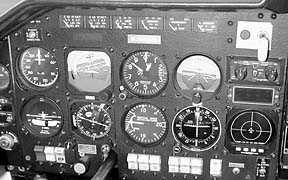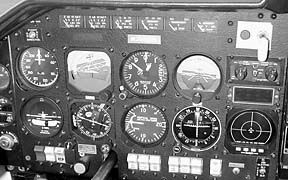
As the world of avionics marches boldly forward, giving us awesome color moving maps and soon the ability to paint weather displays uploaded from ground radar, one aspect of instrument flying is mired in a stagnant backwater: The lowly attitude gyro.
While radios and navigators press the cutting edge, the basic gyro-especially the attitude gyro-has changed little during the past half century. Although AIs arent especially failure prone, watching one roll over from the comfort of a cockpit immersed in solid clag is disconcerting at the least, terrifying at worst.
A recent high-profile accident (see link to “An Ugly Accident”) in which a pilot appears to have lost it due to a gyro failure has sent many an owner scurrying to the airport for partial-panel training and to the avionics shop for a quote on some kind of AI back-up system. No argument from us on the wisdom of either or both. Partial panel without a pitch gyro is serious business in IMC and we think backing up this critical instrument in some way is essential.But whats the most cost-effective and safe way to address this troublesome issue? We recently faced this dilemma when the AI in the company Mooney began acting up. Nothing major, mind you, just subtle bobbles and twists that suggested it was nearing the end. A back-up seemed a good idea.
The Vacuum Problem
The AI back-up problem is two-pronged. Since most primary AIs are vacuum or air driven, maintaining a reliable source of either is one issue, the second is the gyro itself. If you have but one AI, it represents a single-point failure that no sort of back-up vacuum will address.
For this analysis, we’ll focus on guarding against the single-point gyro failure. But first, some discussion of dual vacuum sources. Depending on the panel instruments, we consider dual vacuum sources of some kind to be must-have equipment for serious IFR flying, unless there’s an electric AI aboard. In our Mooney, for example, both the AI and the Century NSD-360 HSI rely on vacuum for gyro operation. (The HSI also needs electricity for its nav display and other functions.)
Although the NSD-360 is common in Mooneys, its far from the standard in other aircraft. A more common system-the Bendix/King KCS 55A-is an all-electric HSI and an airplane equipped with one is likely to have only one vacuum or air gyro: The attitude indicator. In that case, backing up the vacuum with an intake manifold vacuum source or an electric standby pump, while a good idea, still doesnt address the AI single-point failure scenario. Only a second AI will help, either vacuum or electric. (More on that later.)
As for the vacuum back-ups themselves, the choices are somewhat limited. Precise Flights induction-driven system-now called the SVS-III-has proven economical and reliable. We have an earlier version, the SVS-II, in our Mooney. But its best thought of as an emergency get down system and not necessarily something youd use to continue to the destination with a business-as-usual attitude.
A second system of this type, called the Auto-Vac, is sold by A&I products, which also markets the old-style horn venturi system mounted externally on the fuselage. Ugly, perhaps, but reliable and heated to keep it from icing. At present, A&I informs us that they are inactive in the market, pending FAA approval of improvements on all their products. The prices we’ll use here are the last known retail prices. At $550 or thereabouts installed, the Precise Flight SVS III back-up is a good value, considering its relatively quick to install, has few moving parts to fail and will likely provide a more reliable-if limited-vacuum supply than the primary engine-driven pump.
These systems arent recommended for turbocharged aircraft, although owners install them anyway and report acceptable performance. To generate sufficient vacuum to spool up the gyros with induction systems, you’ll probably have to reduce power and descend.
In our Mooney, we can generate sufficient vacuum at 6000 feet and 18 inches MP, yielding perhaps 125 to 130 knots in cruise. Clearly, if you had to hold a high MEA-say 12,000 feet-youd be out of luck with the Precise Flight system or the A&I Auto-Vac induction system. Youre also out of luck if you own a Beech product with pressure rather than vacuum-driven instruments. These use the same primary pumps that vacuum instruments do, drawing off the blow side rather the suck side. Theyre just as susceptible to failure but the induction back-up is no help. Many Bonanzas equipped with IO-470/520s have an auxiliary accessory pad capable of accepting a second dry vacuum pump driven through an electric clutch arrangement that engages automatically if the primary pump fails. If you don’t already have the second dry pump, retrofitting one doesnt strike us as the most cost-effective option.
Rapco sells the electric clutch assembly pump kit for $1850 complete, plus $300 or $500 for labor. Owners tell us the second pump offers limited peace of mind. The clutch is controlled by a vacuum-sensing switch and by a cockpit switch which must be engaged during run-up for routine ground test. Since the back-up pump is the same sort of dry pump used for the primary system, its no more reliable. Some owners have reported clutch and pump failures and have had the system removed. Again, without a second vacuum gyro, youre not protected against a single-point AI failure.
Next up the food chain in cost are electrically driven standby pumps made by Parker Hannifins Airborne Division and by Aero Safe Corp. Both systems are STCd for many models, including Beechcraft pressure systems. These devices consist of conventional vacuum pumps driven by a 14- or 28-volt electric motor. Theyre installed wherever there’s room, either inside the engine compartment or in the tailcone, where they sit idle until needed.
These are expensive systems. The Aero Safe models cost between $1995 and $2095, depending on voltage, while the Airborne systems vary according to aircraft type, ranging from $2410 for a 14-volt Piper to $3255 for a 28-volt Beechcraft pressure system. Service history on these systems appears to be generally good, in that weve only heard a complaint or two about one not working when called upon. (Aero Safe says its had no known failures and no warranty claims in 17 years.) But at the upper end of the cost scale, these systems cost between $2200 and $3500 installed and still don’t address the single-point gyro failure mode.
Electric vs. Vacuum
And that leads us to the next dilemma, if you want a back-up gyro-and we think its a worthy investment-does it make more sense to pony up for an electric model or simply install another vacuum unit?
In our view, the argument favors the electric units but this is entirely aircraft dependent and will be governed by whether the airplane already has back-up vacuum/pressure of some sort. In our Mooney, for example, two instruments-the AI and HSI-rely on vacuum, so weve installed the Precise Flight system for standby vacuum.
In addition to running both instruments, we also retain use of the autopilot, since it relies on the AI for pitch and roll info. Our back-up AI choices were two: A conventional vacuum unit or an electric AI.
Unfortunately, electrics are among the most expensive gyros on the market. A new R.C. Allen unit with an internally lighted face retails for $1695, while overhauled units can be had for about $1000. Weve heard mixed reviews about the reliability and performance of these electric gyros. One we flew with-a new one-was slow to erect and lazy in the air. Ultimately, we conclude that theyre mission adequate if not awe inspiring.
Unfortunately, the step-up is quite expensive. The AIM 305 series (3-inch hole) is undoubtedly a higher quality unit but it comes with a price tag to match, with retail prices in the $4275 to $4475 range. Going smaller doesnt help. A 2-inch AIM electric AI retails for a whopping $7085. Against those prices, the limitations of the R.C. Allen unit seem tolerable.
Our second choice-the one we ultimately selected-was a vacuum gyro, in our case the Sigma-Tek 5000-B37, which retails for $755. This is a factory new, state-of-the-art unit of the same type used in new Cessnas. Valuewise, we think it edges out the rebuilt R.C. Allen electric, but only if there’s a reliable second vacuum source.
You can find better deals on overhauled vacuum AIs. Shopping Trade-A-Plane, we saw rebuilt vacuum instruments for as little as $400. That may sound like a spray-paint overhaul, but we would consider it acceptable for a back-up, since the instrument will be constantly monitored and the likelihood of it failing in concert with the primary AI is remote. Pay your money and take your choice.
No Second Vacuum
But what about the airplane that has no second vacuum source? Or, in the case of Beech systems, where the instruments are pressure not vacuum-driven and only the AI needs to be backed up? In our view, an electric AI-R.C. Allen or AIM-is the more sensible and economic choice and provides the immediate advantage of a fully capable gyro with an independent power source, all with minimal wiring and no plumbing to hassle. If you chose the pressure-instrument option with a back-up air-driven AI, youd need the back-up pump, costing about $3500 installed, plus the pressure instrument-$700 minimum-which means the total job would cost over $4000.
For that sum, you could install an AIM electric AI and have less tubing, wiring and future maintenance to fuss with and, arguably, more reliable back-up. Or, opt for the R.C. Allen overhaul unit, even if the gyro isn’t quite up to AIM standards. These days, the trend among owners is strongly in favor of the electric AI. It has one significant advantage over any vacuum instrument: In the event of a vacuum failure, the electric gyro is erect and immediately available for establishing a safe attitude. The vacuum instrument, on the other hand, may roll over slowly and/or the vacuum fail light may fail to function, meaning precious seconds will be lost while you diagnose the problem and engage the back-up vacuum or pressure system.
Our Sigma-Tek model can have a vacuum-fail flag, which should provide sufficient warning. However, we concede that the electric gyro eliminates the undetected vacuum failure issue. Some owners are becoming obsessive about the electric gyro as well, wondering if it too ought to be backed up by a supplemental power source. The new Cirrus SR20 has only a single vacuum AI (with back-up electric pump) but the electric turn coordinator has a small back-up battery pack capable of operating the gyro for a bit less than an hour.
While we think this is a terrific idea, we also argue that having either two vacuum sources or a single vacuum source with an electric back-up AI is more than adequate for most realistic failure scenarios in single-engine airplanes. If youre trying to protect against a simultaneous dual vacuum and electric failure, consider a twin-engine aircraft or something burning kerosene.
In single-engine piston aircraft, the belt-and-dual-suspender approach reaches the point of diminishing returns somewhere around the $4000 mark. Okay if youve got money to burn, somewhat over the edge if you don’t.
Also With This Article
Click here to view the Gyro Checklist.
Click here to view “An Ugly Accident.”
Click here to view the Gyro/Vacuum System Comparison.





